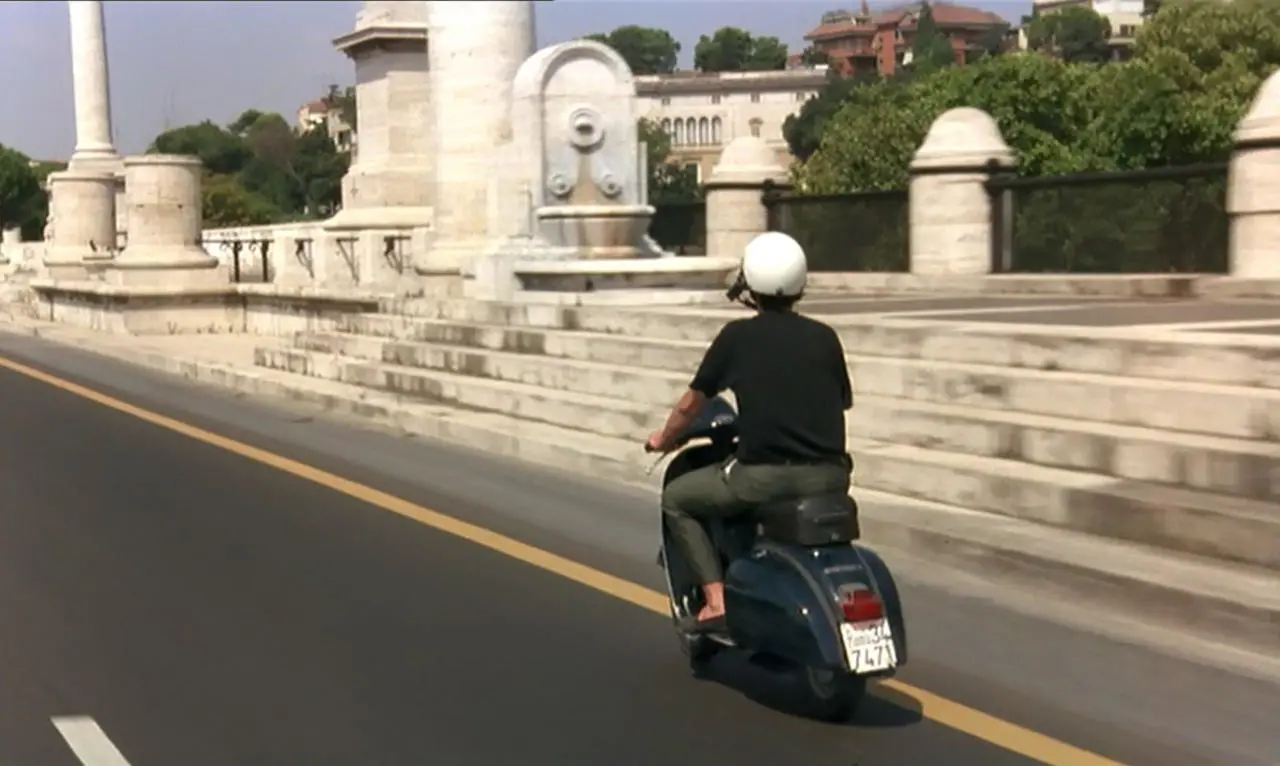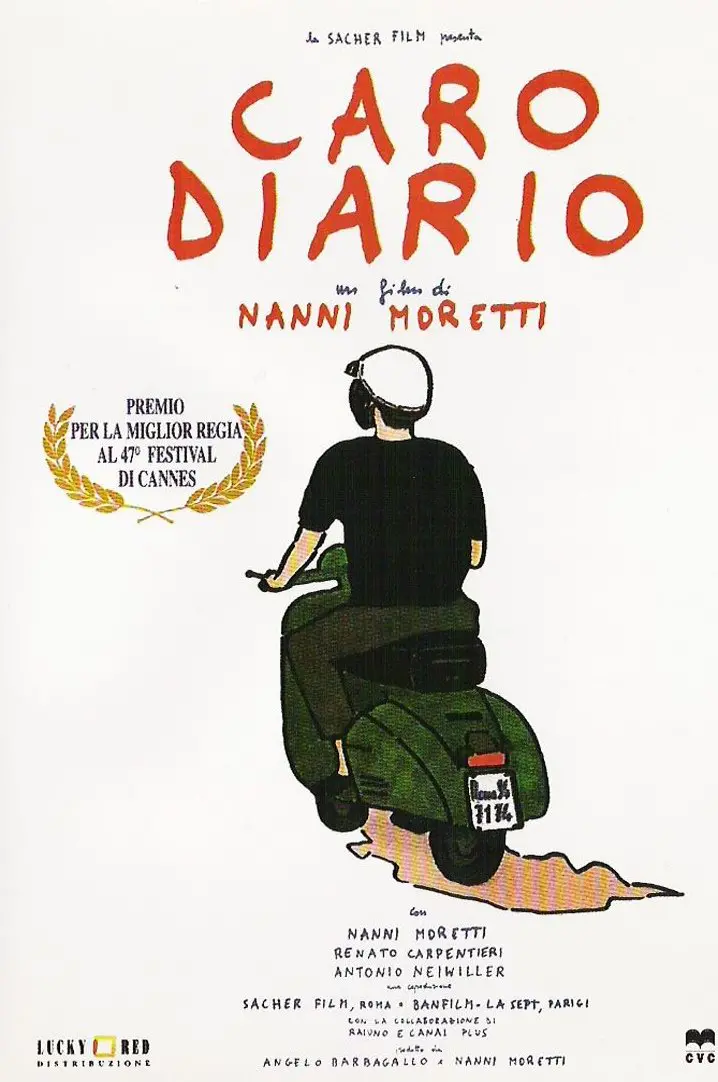
We use cookies
We use cookies and other tracking technologies to improve your browsing experience on our website, to show you personalized content and targeted ads, to analyze our website traffic, and to understand where our visitors are coming from.

On my Vespa
In the first episode, the director drives his Vespa around the districts of a half-deserted Rome in summer, observing the buildings and monuments he sees along the way whilst reflecting on film and life.
We start with the Janiculum, where Moretti drives his Vespa through a very narrow and deserted street.
Still in Northern Rome, the next stop is the elegant streets of Parioli. The director’s first reflection is that in the summer cinemas stay closed or resort to screening porn films or horror splatters of the likes of Henry: Portrait of a Serial Killer, which the director then sees later on at the Fiamma cinema in via Bissolati before sitting down in piazza del Popolo to try to remember who spoke highly of the film.
The Vespa heads along via delle Sette Chiese. Moretti states that he likes seeing the houses and districts, and that is favourite is the Garbatella, a working-class neighbourhood in the capital that came about, we discover later on, in 1927.
Then we see the penthouses he’d like to live in, like those along the lungotevere Flaminio, or on via Dandolo, where the prices soar to around 10 million per square metre given the historic nature of the street. We cross the Flaminio bridge, which the director says he loves and crosses at least twice a day. The tour then takes us along viale Mazzini and to piazza Mazzini. Then Moretti tells us that the film Flashdance changed his life and that he would have liked to learn how to dance instead of merely being a spectator. Moretti then stops off to watch a mambo performance before taking to his Vespa once more and heading off to Spinaceto, a neighbourhood of recent construction that attracts a lot of bad press but is actually “not all that bad”. In the south of Rome we come to Casalpalocco: as he weaves between the houses Moretti notes the smell of video tapes, dogs in gardens and pizzas ready to eat. He asks a local resident why he came to live in this neighbourhood 30 years previously, when Rome was still so beautiful.
He then heads back into the centre via the Ardeatine Walls: when he gets to viale di Porta Ardeatina Moretti meets Jennifer Beals, the protagonist of the film that changed his life: Flashdance. Her impression is that he’s a bit mad, or rather, a ‘bit off’.
Here begins a tracking shot of buildings showing the architectural variety in the capital: Garbatella in 1927, the Olympic Village in 1960, Tufello in 1960, Vigne Nuove in 1987 and Monteverde in 1939.
After skimming through a collection of old newspaper headings documenting the death of Pasolini on 2 November 1975, Moretti decides to go and visit the place where the writer was killed, confessing that he’s never been. The last leg of his journey by Vespa is therefore to Ostia along via dell’Idroscalo, finishing up in front of the monument built in memory of the writer, a modern piece in rough concrete by sculptor Mario Rosati, which was left abandoned for 20 years.
The Islands
In the second part of the film, Moretti journeys with his friend Gerardo to the Aeolian Islands in search of peace. Their first stop is a Lipari heaving with cars and tourists. To escape the confusion they head to Salina, where it seems that every couple has one child that rules them. In the meantime Gerardo, an academic with a self-proclaimed allergy to television, is enthralled and ends up swinging to the opposite extreme, becoming heavily dependent on television. On the next island, Stromboli, the pair are met by a rather megalomaniacal mayor, who loads them into a three-wheeled Ape to take them to his friends’ house, but can’t find anywhere to put them up: indeed, the locals aren’t very hospitable, perhaps as a result of the volcano towering over the island. It is on the very slopes of the smoking volcano that the pair finally seem to find their feet, but Gerardo finds a group of American hikers and is overtaken by the compelling need to find out what happens in the episodes of soap opera The Bold and the Beautiful that have yet to be aired in Italy.
On Panarea, the most outermost island in the archipelago, the two friends decide to get back on the same hydrofoil they arrived on before they even set foot on the island when a group of entertainers try to involve them in various merrymaking activities.
Their last stop is Alicudi, the least civilised of all the Aeolian Islands, for “people who hate narcissism”: here the pair finally finds peace – there are no roads, just stone paths weaving between dry stone walls in the middle of an unspoilt landscape littered with prickly pear trees. There are no home comforts here and no electricity, so no TV: this proves too much for the now TV addicted Gerardo.
Doctors
The third part of the film recounts the protagonist’s ordeal at dermatological centres and studios of the capital, where he receives contrasting opinions and prescriptions for useless treatments before finding out that he has Hodgkin’s lymphoma.
On my Vespa
In the first episode, the director drives his Vespa around the districts of a half-deserted Rome in summer, observing the buildings and monuments he sees along the way whilst reflecting on film and life.
We start with the Janiculum, where Moretti drives his Vespa through a very narrow and deserted street.
Still in Northern Rome, the next stop is the elegant streets of Parioli. The director’s first reflection is that in the summer cinemas stay closed or resort to screening porn films or horror splatters of the likes of Henry: Portrait of a Serial Killer, which the director then sees later on at the Fiamma cinema in via Bissolati before sitting down in piazza del Popolo to try to remember who spoke highly of the film.
The Vespa heads along via delle Sette Chiese. Moretti states that he likes seeing the houses and districts, and that is favourite is the Garbatella, a working-class neighbourhood in the capital that came about, we discover later on, in 1927.
Then we see the penthouses he’d like to live in, like those along the lungotevere Flaminio, or on via Dandolo, where the prices soar to around 10 million per square metre given the historic nature of the street. We cross the Flaminio bridge, which the director says he loves and crosses at least twice a day. The tour then takes us along viale Mazzini and to piazza Mazzini. Then Moretti tells us that the film Flashdance changed his life and that he would have liked to learn how to dance instead of merely being a spectator. Moretti then stops off to watch a mambo performance before taking to his Vespa once more and heading off to Spinaceto, a neighbourhood of recent construction that attracts a lot of bad press but is actually “not all that bad”. In the south of Rome we come to Casalpalocco: as he weaves between the houses Moretti notes the smell of video tapes, dogs in gardens and pizzas ready to eat. He asks a local resident why he came to live in this neighbourhood 30 years previously, when Rome was still so beautiful.
He then heads back into the centre via the Ardeatine Walls: when he gets to viale di Porta Ardeatina Moretti meets Jennifer Beals, the protagonist of the film that changed his life: Flashdance. Her impression is that he’s a bit mad, or rather, a ‘bit off’.
Here begins a tracking shot of buildings showing the architectural variety in the capital: Garbatella in 1927, the Olympic Village in 1960, Tufello in 1960, Vigne Nuove in 1987 and Monteverde in 1939.
After skimming through a collection of old newspaper headings documenting the death of Pasolini on 2 November 1975, Moretti decides to go and visit the place where the writer was killed, confessing that he’s never been. The last leg of his journey by Vespa is therefore to Ostia along via dell’Idroscalo, finishing up in front of the monument built in memory of the writer, a modern piece in rough concrete by sculptor Mario Rosati, which was left abandoned for 20 years.
The Islands
In the second part of the film, Moretti journeys with his friend Gerardo to the Aeolian Islands in search of peace. Their first stop is a Lipari heaving with cars and tourists. To escape the confusion they head to Salina, where it seems that every couple has one child that rules them. In the meantime Gerardo, an academic with a self-proclaimed allergy to television, is enthralled and ends up swinging to the opposite extreme, becoming heavily dependent on television. On the next island, Stromboli, the pair are met by a rather megalomaniacal mayor, who loads them into a three-wheeled Ape to take them to his friends’ house, but can’t find anywhere to put them up: indeed, the locals aren’t very hospitable, perhaps as a result of the volcano towering over the island. It is on the very slopes of the smoking volcano that the pair finally seem to find their feet, but Gerardo finds a group of American hikers and is overtaken by the compelling need to find out what happens in the episodes of soap opera The Bold and the Beautiful that have yet to be aired in Italy.
On Panarea, the most outermost island in the archipelago, the two friends decide to get back on the same hydrofoil they arrived on before they even set foot on the island when a group of entertainers try to involve them in various merrymaking activities.
Their last stop is Alicudi, the least civilised of all the Aeolian Islands, for “people who hate narcissism”: here the pair finally finds peace – there are no roads, just stone paths weaving between dry stone walls in the middle of an unspoilt landscape littered with prickly pear trees. There are no home comforts here and no electricity, so no TV: this proves too much for the now TV addicted Gerardo.
Doctors
The third part of the film recounts the protagonist’s ordeal at dermatological centres and studios of the capital, where he receives contrasting opinions and prescriptions for useless treatments before finding out that he has Hodgkin’s lymphoma.

Sacher Film, Banfilm, La Sept Cinéma
A film divided into three episodes in which Moretti plays himself. In the first episode, On my Vespa, the protagonist drives around Rome in August on his scooter in search of unusual places. In the second episode, Islands, the protagonist tours the Aeolian islands with a friend who doesn’t care for television. The third episode, Doctors, is the story of Moretti’s long-term illness.